The Real Cost of Intensive Outpatient Rehab: What to Expect Up Front
The cost of intensive outpatient rehab is a top concern for anyone considering treatment. If you just want fast facts, here’s what you need to know:
| Program Type | Typical Total Cost | Daily Cost | With Insurance | Without Insurance |
|---|---|---|---|---|
| Intensive Outpatient (IOP) | $2,000–$10,000 | $250–$350 | 50%–80% Covered | Full Amount |
| Inpatient/Residential | $14,000–$27,000+ | $500–$950 | 50%–80% Covered | Full Amount |
| Standard Outpatient | $1,400–$10,000 | $50–$150 | Often 50%+ Covered | Full Amount |
Average IOP cost in the U.S. is about $5,000–$10,000 for a full program (8–12 weeks), but prices vary by city, amenities, insurance, and session frequency.
“Intensive Outpatient Programs (IOPs) are typically cheaper and more cost-effective than traditional inpatient treatment options.”
— Freedom Center IOP guide
What drives the bill?
- Location: Urban centers cost more.
- Duration & Frequency: Longer or more frequent sessions mean higher total cost.
- Insurance: Most plans cover 50–80%, but always verify your out-of-pocket maximums.
- Extras & Amenities: Luxury facilities charge more for privacy, comfort, or specialty care.
- Treatment Type: Dual-diagnosis or medical add-ons increase price.
If you’re comparing options, IOP offers a balance: intensive support with flexible scheduling and significantly lower total cost than inpatient rehab.
I’m Clint Kreider. With a Master’s in Clinical Psychology and years in both private practice and addiction treatment, I’ve helped clients understand the cost of intensive outpatient rehab and find the best plan for their needs.
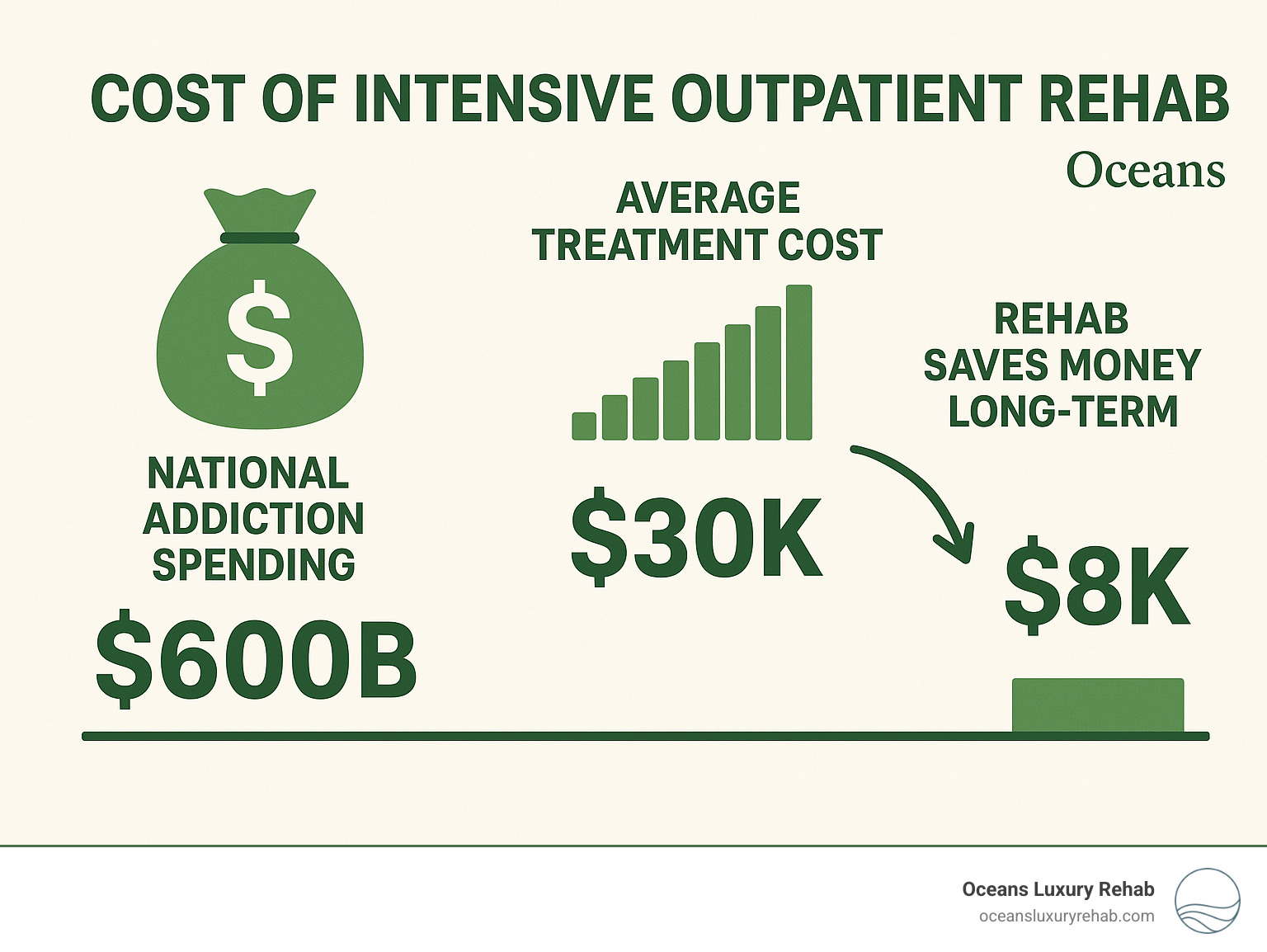
Must-know cost of intensive outpatient rehab terms:
Understanding the Cost of Intensive Outpatient Rehab

Let’s break down what you’re actually paying for when you look at the cost of intensive outpatient rehab. An IOP isn’t just regular therapy – it’s a structured program that gives you intensive support while letting you keep your normal life going.
Think of it as the middle ground between living at a treatment facility and seeing a therapist once a week. You’ll typically spend 7-10 hours per week in treatment, usually spread across 3-5 days with sessions lasting 2-4 hours each. Most programs run for 8-12 weeks, though some extend up to 90 days if you need more time.
The real beauty of IOP? You can still go to work, take care of your kids, or handle whatever life throws at you. You’re getting serious help without putting your whole life on pause.
Scientific research on effectiveness of IOP shows these programs work just as well as inpatient treatment for many people. That makes the cost comparison pretty compelling when you’re trying to decide what’s right for you.
| Treatment Level | Weekly Hours | Duration | Total Cost Range | Best For |
|---|---|---|---|---|
| Intensive Outpatient (IOP) | 7-10 hours | 8-12 weeks | $2,000-$10,000 | Motivated individuals with home support |
| Inpatient/Residential | 24/7 care | 30-90 days | $14,000-$60,000+ | Severe addiction, medical complications |
| Standard Outpatient | 1-3 hours | 12+ weeks | $1,400-$10,000 | Mild addiction, strong support system |
| Partial Hospitalization (PHP) | 20+ hours | 2-8 weeks | $10,000-$15,000 | Step-down from inpatient |
Average Price Tag: cost of intensive outpatient rehab in the U.S.
Here’s the number you’re probably looking for: the cost of intensive outpatient rehab typically runs between $2,000 and $10,000 for a complete program. If you break that down per session, you’re looking at about $250 to $350 each time you walk through the door.
But here’s the thing – these numbers only tell part of the story. Treatment costs have been climbing steadily. What used to cost $1,384-$5,780 back in 2016 now runs about $1,908-$7,969 when you adjust for inflation.
The national average for all drug rehabilitation sits at $13,475 per person, but IOP programs consistently come in well below that figure. That’s good news for your wallet.
Location makes a huge difference in what you’ll pay. In California (like our Orange County location), luxury programs can run $8,000-$12,000. Florida tends to be a bit more affordable at $5,000-$8,000 for standard programs. Texas often comes in even lower at $4,000-$7,000. New York urban programs can hit $7,000-$11,000. And if you’re in a rural area, you might find programs for $3,000-$6,000.
More info about outpatient rehab costs can help you understand how these numbers stack up against other treatment options.
What Drives the Bill? Location, Length & Level of Care
Several things can make your cost of intensive outpatient rehab go up or down, and understanding them helps you plan better.
Where you live matters more than you might think. Urban centers like Orange County and Los Angeles charge more because everything costs more there – rent, staff salaries, even the coffee in the waiting room. But you also get access to more specialized services and nicer facilities. Rural programs might cost 30-50% less, but they might not have all the bells and whistles.
How long you stay in treatment directly affects your total cost. A standard 8-12 week program costs less than a 90-day extended program. But here’s the catch – longer programs often work better long-term, which could save you money by preventing future relapses and additional treatment needs.
The intensity level you choose changes everything. Programs that meet 3 days per week cost less than those requiring 5 days. Four-hour daily sessions cost more than 2-hour sessions. It’s pretty straightforward math.
Amenities and extras can double or triple your costs. Luxury facilities offering private rooms, gourmet meals, spa services, or beautiful locations charge accordingly. At Oceans Luxury Rehab, we provide comprehensive luxury care that includes 24-hour nursing support and specialized medical attention – because sometimes the extra comfort and care make all the difference in your recovery.
Dual-diagnosis care – treating mental health conditions alongside addiction – typically adds 20-40% to your bill. You’re paying for additional psychiatric services and specialized staff who know how to handle complex cases.
Staff expertise matters too. Programs with board-certified addiction specialists, licensed therapists, and medical doctors cost more than those using primarily counselors or peer support specialists. You’re paying for their years of training and experience.
IOP vs Inpatient, PHP & Standard Outpatient: Dollars & Sense
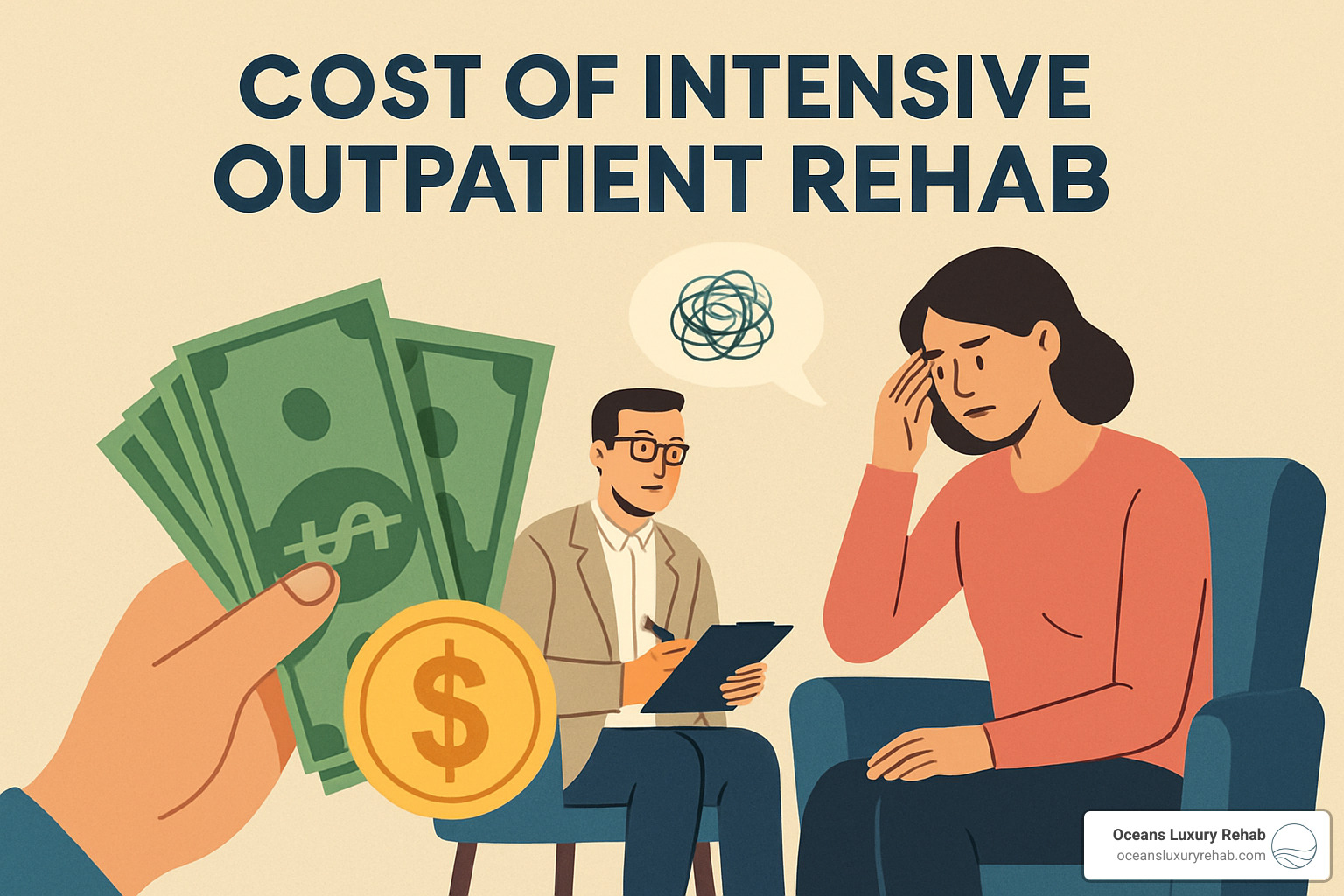
When you compare costs across different treatment levels, you start to see why IOP has become so popular.
Intensive outpatient versus inpatient is where the savings really show up. Inpatient programs average $14,000-$27,000 for just 4 weeks. Meanwhile, IOP programs give you 8-12 weeks of treatment for $2,000-$10,000. You’re getting longer treatment time at a fraction of the cost.
IOP versus partial hospitalization also favors IOP. PHP programs cost $10,000-$15,000 for just 2-8 weeks, making IOP much more cost-effective for longer-term support.
IOP versus standard outpatient is where it gets interesting. Standard outpatient costs less per session ($50-$150), but IOP gives you more intensive support that can prevent relapse. Sometimes spending more upfront saves you from needing treatment again later.
Research shows that well-structured IOP programs can get you the same results as inpatient rehab. That makes the cost savings even sweeter. Plus, with IOP, you don’t lose income from missing work, which could save you thousands in lost wages.
More info about Outpatient Rehab explains how these different levels of care work together in a comprehensive treatment approach.
Insurance Coverage & Out-of-Pocket Math
Most health insurance plans cover 50-80% of IOP costs, but understanding your specific benefits is crucial for planning what you’ll actually pay.
Copays and deductibles can vary wildly. You might pay a $20 copay per session, or you might face a $1,000 deductible before your coverage kicks in. HMO plans typically have lower copays but require referrals from your primary doctor. PPO plans give you more flexibility but usually come with higher out-of-pocket costs.
In-network benefits can cut your costs by 50-70%. Out-of-network care might only be covered at 50-60% even after you meet your deductible. It pays to check whether your chosen program is in your insurance network.
ACA parity laws are on your side here. The Affordable Care Act requires insurance plans to cover mental health and substance abuse treatment at the same level as physical health care. If your plan covers 80% of medical procedures, it must cover 80% of addiction treatment too.
Medicare and Medicaid both cover IOP when it’s deemed medically necessary, including therapy and medication management. Medicaid coverage varies by state, with some states covering 100% of IOP costs.
Coverage limits are something to watch out for. Many plans cap the number of sessions per year or have annual maximums for mental health treatment. Understanding these limits helps avoid surprise bills that can derail your recovery plans.
Scientific research on insurance factors provides detailed information about federal requirements for addiction treatment coverage.
More info about Does Insurance Cover Drug Rehab? offers specific guidance on navigating insurance claims and getting the most from your benefits.
Paying Smart: Reducing the Bill & Maximizing Value
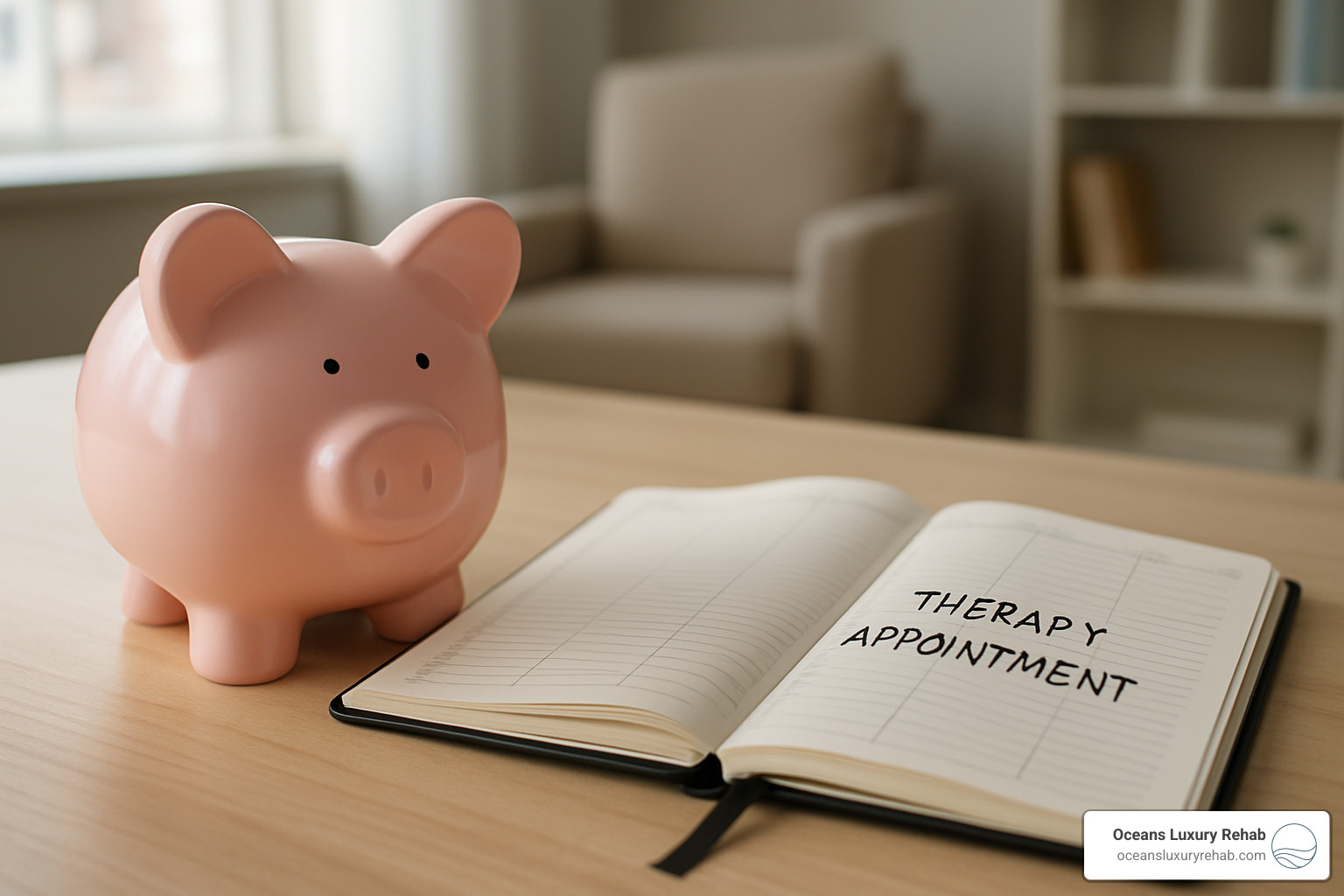
Nobody wants to pay more than they have to for treatment. The good news? There are real ways to reduce your cost of intensive outpatient rehab while still getting excellent care. I’ve helped hundreds of clients steer these options, and the savings can be substantial.
The key is knowing where to look and asking the right questions. Many people assume they can’t afford quality treatment, but with the right approach, IOP becomes much more manageable financially.
Payment Options & Financial Assistance for cost of intensive outpatient rehab
Your insurance might cover more than you think. Before you panic about costs, call your insurance company directly. Ask about in-network IOP providers, your annual deductible, and what percentage they cover for outpatient addiction treatment. Many people find they have better coverage than expected.
Self-pay discounts are surprisingly common. Most facilities offer 10-20% off if you pay upfront. Some programs break down costs into manageable chunks – for example, spreading $8,400 over your entire treatment period rather than paying it all at once.
Your employer might be your secret weapon here. Employee Assistance Programs (EAP) often cover addiction treatment costs that many people never use. These programs typically provide several free sessions and can supplement whatever your insurance doesn’t cover.
SAMHSA grants provide another avenue for financial help. Call 1-800-662-HELP to learn about state-funded programs in your area. The Substance Abuse and Mental Health Services Administration offers grants specifically for treatment costs.
Here’s something that might surprise you: 76% of substance abuse treatment centers offer payment assistance. About 38% provide mixed free and sliding-scale options, while 24% offer sliding-scale fees based on your income. You just have to ask.
State-funded programs vary by location, but they’re worth investigating. In New Jersey, for example, 72% of IOP participants used government support in 2021. Your state might have similar programs.
Don’t forget about tax deductions either. IOP treatment costs may qualify as medical expense deductions under IRS Topic 502, potentially providing additional savings when you file your taxes.
More info about Intensive Outpatient Program shows how we work with clients to find affordable treatment solutions that fit their budget.
Scientific research on economic benefits demonstrates the long-term financial benefits of investing in quality treatment.
Why Investing Now Saves Money Later
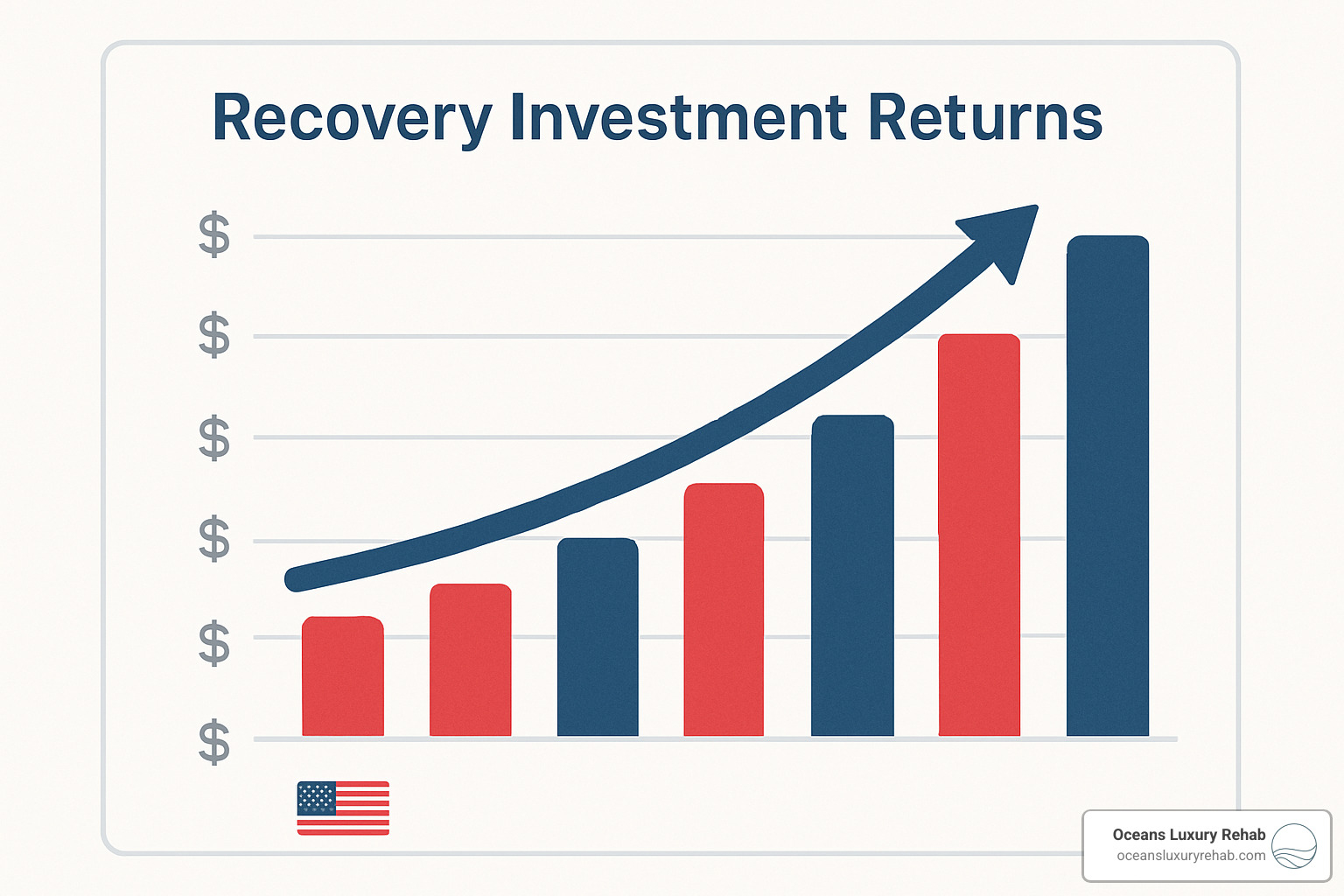
Let’s talk about the real math behind recovery. The cost of intensive outpatient rehab isn’t just an expense – it’s an investment that pays massive dividends.
Lost productivity from addiction costs the U.S. over $600 billion annually. On a personal level, someone drinking a 12-pack daily spends over $3,000 yearly just on alcohol. That’s $30,000 over a decade, not counting the health problems that come with it.
Healthcare expenses multiply fast with untreated addiction. Emergency room visits, hospitalizations, and chronic health conditions pile up. The average person with untreated addiction spends 2-3 times more on healthcare than someone in recovery.
Legal fees can devastate your finances overnight. A single DUI arrest can cost $10,000-$50,000 between fines, legal fees, and increased insurance rates. One avoided legal issue can pay for an entire IOP program.
Employment stability improves dramatically in recovery. People in recovery maintain jobs at much higher rates, with stable income streams that far exceed treatment costs. During active addiction, the average person loses $20,000-$40,000 in income.
Family and relationship costs add up too. Addiction strains relationships, leading to divorce, custody battles, and family therapy needs. Recovery preserves these relationships and avoids the financial devastation that often follows.
The ROI of sobriety is remarkable. Studies show that every dollar spent on addiction treatment saves $4-$7 in reduced healthcare costs, criminal justice expenses, and increased productivity. For IOP specifically, the return on investment often exceeds 300% within the first year of recovery.
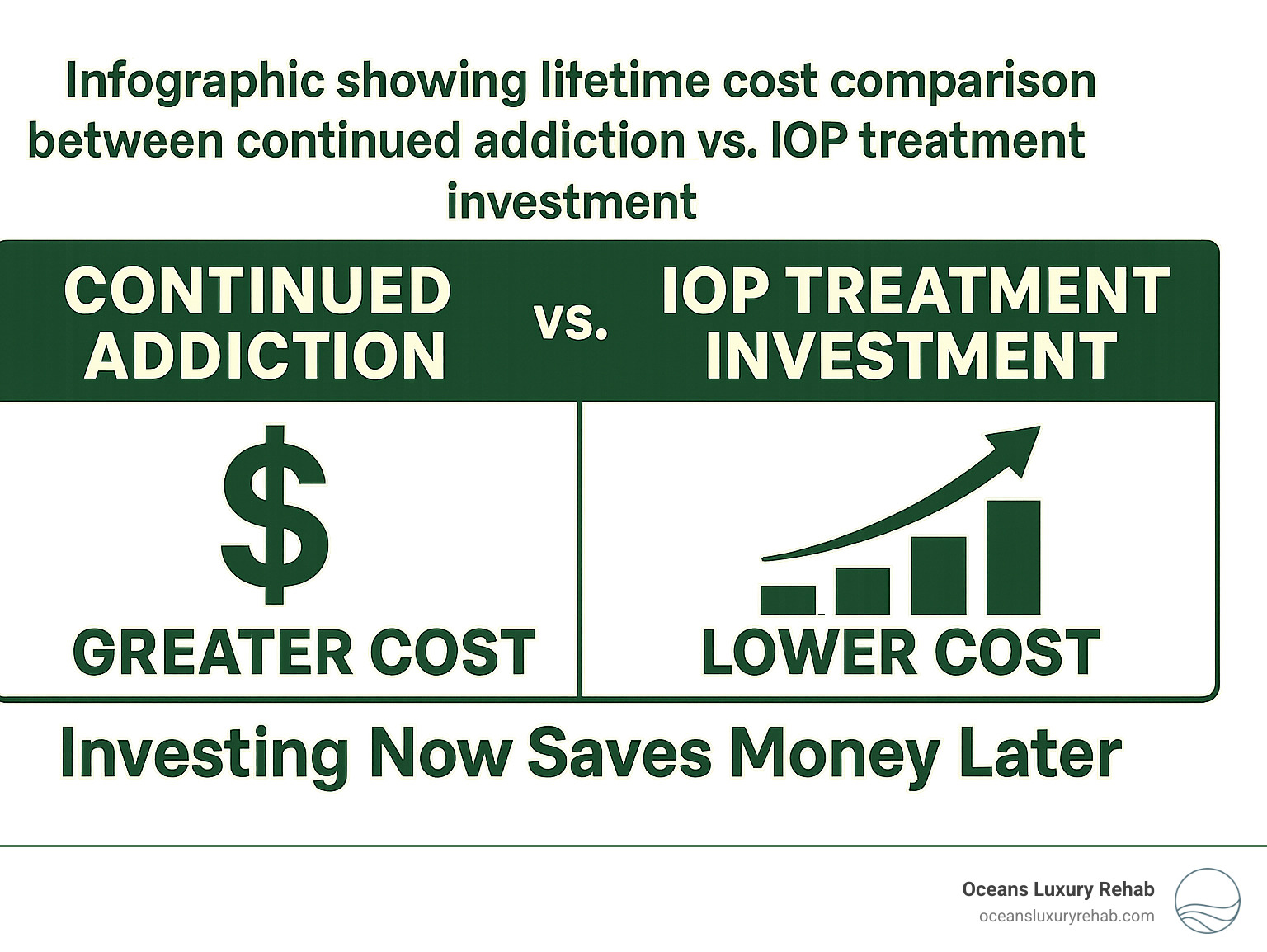
At Oceans Luxury Rehab, we’ve seen countless clients whose IOP investment transformed their lives financially. Our comprehensive approach includes luxury amenities and 24-hour medical support, ensuring you get maximum value from your treatment investment.
The math is simple: while the upfront cost may seem significant, the long-term savings in healthcare, legal fees, lost productivity, and relationship preservation make it one of the smartest financial decisions you can make. When you factor in the priceless value of your health, relationships, and peace of mind, IOP treatment pays for itself many times over.
You’re not just paying for treatment – you’re investing in your future, your family’s stability, and your long-term financial health. The cost of not getting help is always higher than the cost of quality treatment.
